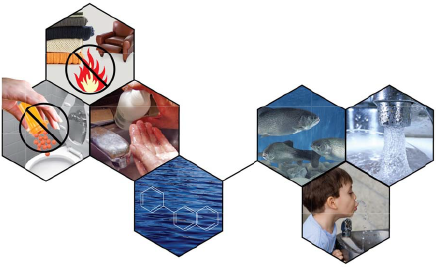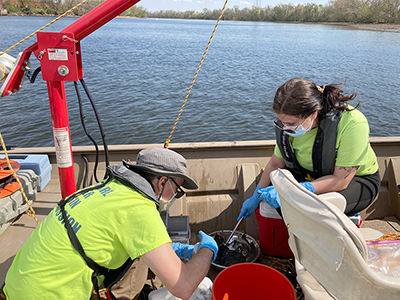Delaware • New Jersey • Pennsylvania
New York • United States of America
- Aquatic Life Designated Use Project
- Bacteria Monitoring
- Biomonitoring Program
- Chlorides Monitoring
- Contaminants of Emerging Concern
- Delaware Estuary Water Quality Monitoring Program
- Dissolved Oxygen and Nutrients
- Modeling
- Other Monitoring (e.g., Toxicity, Fish Tissue, Metals)
- PCBs and PMPs
- Special Protection Waters (SPW)
- Water Resource Data Sets
- What are Contaminants of Emerging Concern?
- DRBC Monitoring Efforts
- Presentations and Reports
- Informational Links
- Drug Take-Back/Disposal Information
 |
Contaminants of emerging concern (CECs) are chemicals present in substances or products used by humans that have been detected in surface waters and groundwater, potentially impacting water quality, aquatic species and drinking water sources. Some have been around for a long time, but are considered emerging due to new exposure pathways to humans.
CECs have been found to persist in the environment and have been detected in people and other living organisms. Many of these compounds are currently unregulated and not routinely monitored.
A growing body of information on the adverse effects of CECs, as well as improved analytical detection methods, have caused increased interest and concern about how these substances impact our water resources.
Learn More about CECs
• 6PPD-Q
Other Examples of CECs
• PBDEs: brominated flame retardants
• Nanoparticles
• Pharmaceuticals and Personal Care Products (PPCPs)
• Pesticides
• Plasticizers
• Synthetic Hormones
 |
| DRBC staff collects a sediment sample from the Delaware River to monitor for PFAS. Photo by DRBC. |
A number of efforts have been undertaken within the Delaware River Basin by the DRBC, the basin states and the U.S. EPA to identify CECs and understand their presence, sources, pathways, persistence and how they degrade in surface water.
DRBC Monitoring
From 2007-2009, DRBC conducted a Pilot Monitoring Survey to investigate the presence and concentration of PPCPs, PFAS and PBDEs in the ambient waters of the tidal Delaware River.
• Pilot Monitoring Survey (pdf)
In 2013, DRBC and the Water and Environmental Technology (WET) Center at Temple University partnered on a grant-funded survey to study CECs in several southeastern Pennsylvania tributaries to the tidal Delaware River. Tributaries surveyed included the Neshaminy, Perkiomen and Wissahickon creeks and the Schuylkill River, all of which have numerous municipal and industrial discharges to surface water. Ten sampling sites were surveyed, the chosen locations above and below potential source discharges for CECs. The survey was completed in March 2014.
Today, the DRBC performs periodic monitoring for CECs in surface water, sediment and fish tissue.
Commission staff continues to cooperate with the basin states, U.S. EPA and academics on a prioritized list of PPCPs, PFAS and polybrominated diphenyl ethers in order to further evaluate sources, fate and effects in surface water, sediment and fish tissue.
Commission staff are also developing a DRBC Contaminants of Emerging Concern Strategy in consultation with its Toxics Advisory Committee (TAC).
The below presentations and reports are by DRBC staff or given at DRBC advisory committee meetings.
Contaminants of Emerging Concern (CECs)
- It's Everywhere, but is it Toxic? A Basin-Wide Survey of 6PPD-Q in Brook Trout Waters of the Delaware River Basin (pdf; presentation given October 2025)
- Penn State Extension Water Cooler Talk: PFAS & 6PPD-Q in the Delaware River Basin (pdf; presentation given August 2025)
- Characterization of PFAS in Surface Water, Sediment and Fish in the Pennsylvania Coastal Zone (pdf; July 2025)
- Enhanced Monitoring for Toxics and Emerging Contaminants in Delaware Estuary Tributaries (pdf; April 2025)
- Per- and Polyfluoroalkyl Substances (PFAS) in Urbanized Section of the Delaware River Watershed: Risk Assessment and Geographical Distribution (pdf; March 2025 paper co-authored by DRBC staff. Full citation: Akbari, E., Shah, T., Nazaruk, K. et al. Per- and Polyfluoroalkyl Substances (PFAS) in Urbanized Section of the Delaware River Watershed: Risk Assessment and Geographical Distribution. Water Air Soil Pollut 236, 192 (2025). Online: https://doi.org/10.1007/s11270-025-07835-0)
- PFAS Water Quality and Fish Tissue Assessment Study: Year 2 (pdf; March 2024)
- DRBC's Toxics and Research Planning (pdf; presentation given to the Toxics Advisory Committee; February 2024)
- Per- & polyfluorinated alkyl substances (PFAS) in Pennsylvania surface waters: a statewide assessment & associated sources (pdf; presentation given to the Toxics Advisory Committee by Sara E. Breitmeyer, USGS; February 2024)
- DRBC PFAS Monitoring and Collaborators in the Delaware River Basin (pdf; presentation given at the Mid-Atlantic Source Water Protection Leadership Forum; November 2023)
- PFAS Water Quality and Fish Tissue Assessment Study: Year 1 (pdf; July 2023)
- PFAS in Surface Water, Sediment and Fish in the Pennsylvania Coastal Zone (Technical report authored by DRBC staff and financed, in part, through a Federal Coastal Zone Management Grant, administered by the Pennsylvania Department of Environmental Protection; pdf; July 2023)
- DRBC Project Updates (pdf; presentation given at the DRBC TAC Meeting; June 2023)
- DRBC PFAS Monitoring Update (pdf; presentation given at the DRBC TAC Meeting; June 2022)
- Temporal Trends of Per‐ and Polyfluoroalkyl Substances in Delaware River Fish, USA (September 2020 paper authored by DRBC staff published in Integrated Environmental Assessment and Management, 2021;17:411–421. Full citation: MacGillivray, A.R. (2021) Temporal trends of PFAS in Delaware River Fish, USA. Integrated Environmental Assessment and Management. 17(2) 411-421)
- Lessons Learned from other Watersheds: Delaware River Basin Contaminants of Emerging Concern Surveys & PCB TMDL (pdf; presentation given at a Chesapeake Bay STAC workshop; May 2019)
- Contaminants of Emerging Concern in the Tidal Delaware River: Pilot Monitoring Survey 2007-2009 (pdf; revised August 2013) Data in this report are available in alternate formats (analytical laboratory package or electronic data summaries) upon request.
- Ambient Water Monitoring of the Delaware River for Emerging Contaminants: Quality Assurance Project Plan (pdf; October 2007)
- DRBC's Quality Management Plan (pdf; December 2011)
- Appendix E: 2017 Monitoring Survey of PPCP and Hormones in Surface Water to Contaminants of Emerging Concern in the Tidal Delaware River Pilot Monitoring Survey (pdf; Sept. 2017)
- Contaminants of Emerging Concern Strategy (pdf; presentation given to the Toxics Advisory Committee; July 2018)
- Emerging Contaminants in the Delaware River Basin (pdf; presentation given to the Schuylkill Action Network; January 2018)
- Contaminants of Emerging Concern in the Delaware River Basin (pdf; presentation given at the Chemistry Council of New Jersey's Spring Conference; May 2016)
-
Emerging Contaminants in the Delaware Estuary (pdf; presentation given at the 2011 Partnership for the Delaware Estuary's Science and Environmental Summit)
-
Contaminants of Emerging Concern in the Delaware River Estuary (pdf; presentation given at Feb. 2010 National Estuary Program Meeting)
Pharmaceuticals and Personal Care Products (PPCP)
- Occurrence and Aquatic Toxicity of Contaminants of Emerging Concern (CECs) in Tributaries of an Urbanized Section of the Delaware River Watershed (July 2020 paper co-authored by DRBC staff published in AIMS Environmental Science, (4): 302-319)
- Contaminants of Emerging Concern in the Delaware River Basin (pdf; presentation given at the Sept. 2014 DE-AWRA Roundtable Panel Discussion "Pharmaceuticals and Personal Care Products in Water")
- Fate of Triclosan in Tertiary Wastewater Treatment: Chlorination (November 2013 paper co-authored by DRBC staff published in the Water Quality Research Journal of Canada Vol. 48/Issue 4)
- PPCPs at a Point Source (Publicly Owned Treatment Works) Discharge Before and After Tertiary Disinfection by Chlorination (pdf; presentation given at the Nov. 2010 SETAC North America Annual Meeting)
- Endocrine Disrupting Compounds (EDC) Footprint Calculator
- National Centers for Coastal Ocean Science: Contaminants of Emerging Concern (part of NOAA)
- New Jersey DEP: Contaminants of Emerging Concern
- NYSDEC: Management of Hazardous Waste Pharmaceuticals
- NYSDEC: Managing and Disposing of Household Hazardous Waste (pdf)
- New York State: Pollution Prevention Institute: Resources about Chemical Use
- PADEP: Contaminants of Emerging Concern
- Science Direct: Emerging Contaminants
- U.S. Environmental Protection Agency (USEPA): Contaminants of Emerging Concern including Pharmaceuticals and Personal Care Products
- U.S. EPA Safer Choice Product Information
- U.S. Geological Survey (USGS): Emerging Contaminants
- USGS: Environmental Health Program
- White House: National Emerging Contaminants Research Initiative (NECRI; pdf) and NECRI Implementation Plan (pdf)
- AWARxE Prescription Drug Safety Program Disposal Site Locator Tool
- Delaware Health and Social Services' Division of Public Health: Prescription Drug Disposal Information
- National Prescription Drug Take-Back Day
- New Jersey Division of Consumer Affairs: Project Medicine Drop
- New York Dept. of Environmental Conservation (NYSDEC): Safe Medication Disposal for Households
- Pennsylvania Dept. of Drug and Alcohol Programs: Healthy Pennsylvania - Prescription Drug Take-Back Program
- Product Stewardship Institute's Safe Drug Disposal Portal
- Safe Pharmacy: Dispose My Meds Pharmacy Locator
- U.S. DEA: Drug Disposal Information
- U.S. Food and Drug Administration: How to Dispose of Unused Medicine
Copyright © Delaware River Basin Commission,
P.O. Box 7360, West Trenton, NJ 08628-0360
Phone (609)883-9500; Fax (609)883-9522
Thanks to NJ for hosting the DRBC website